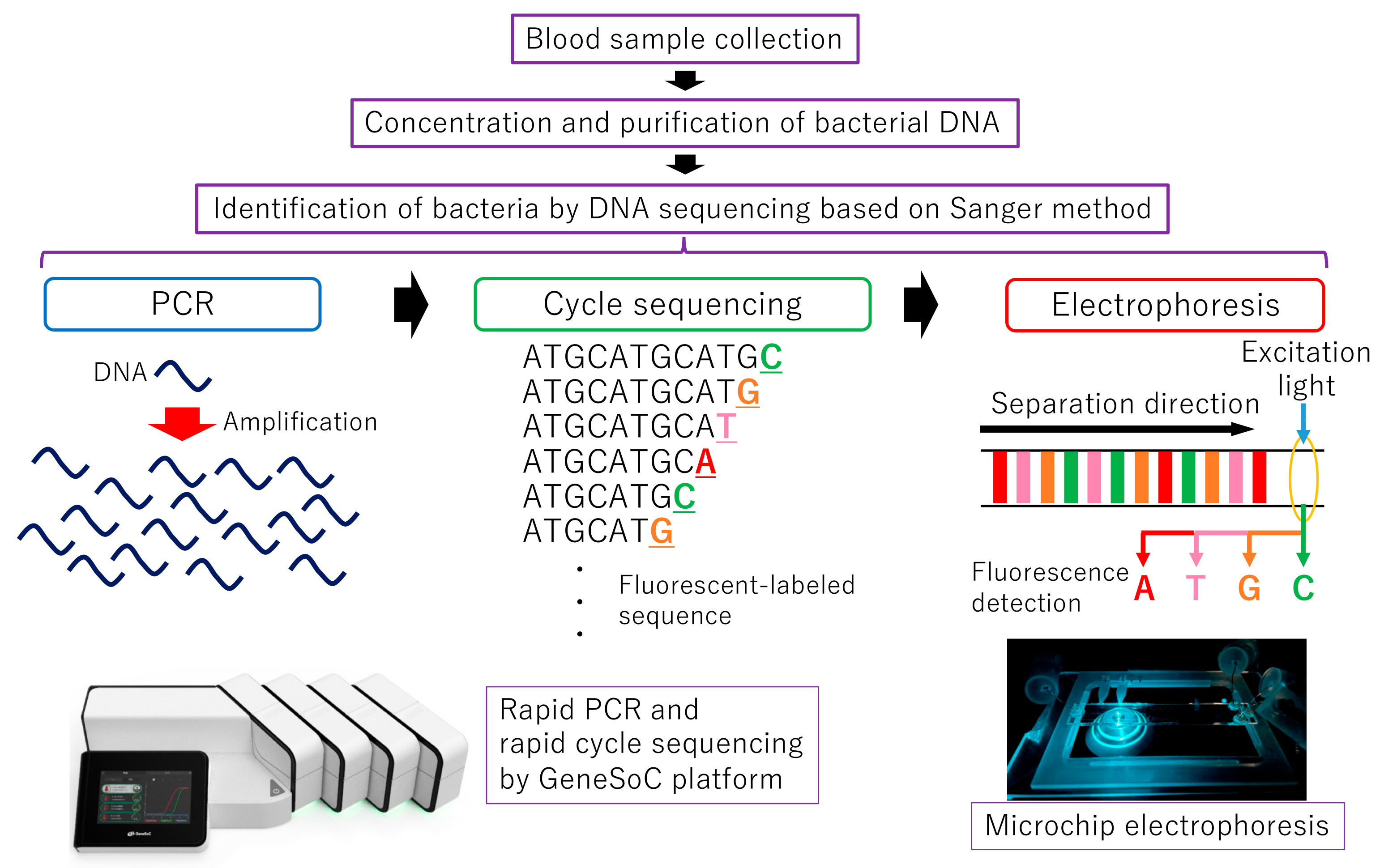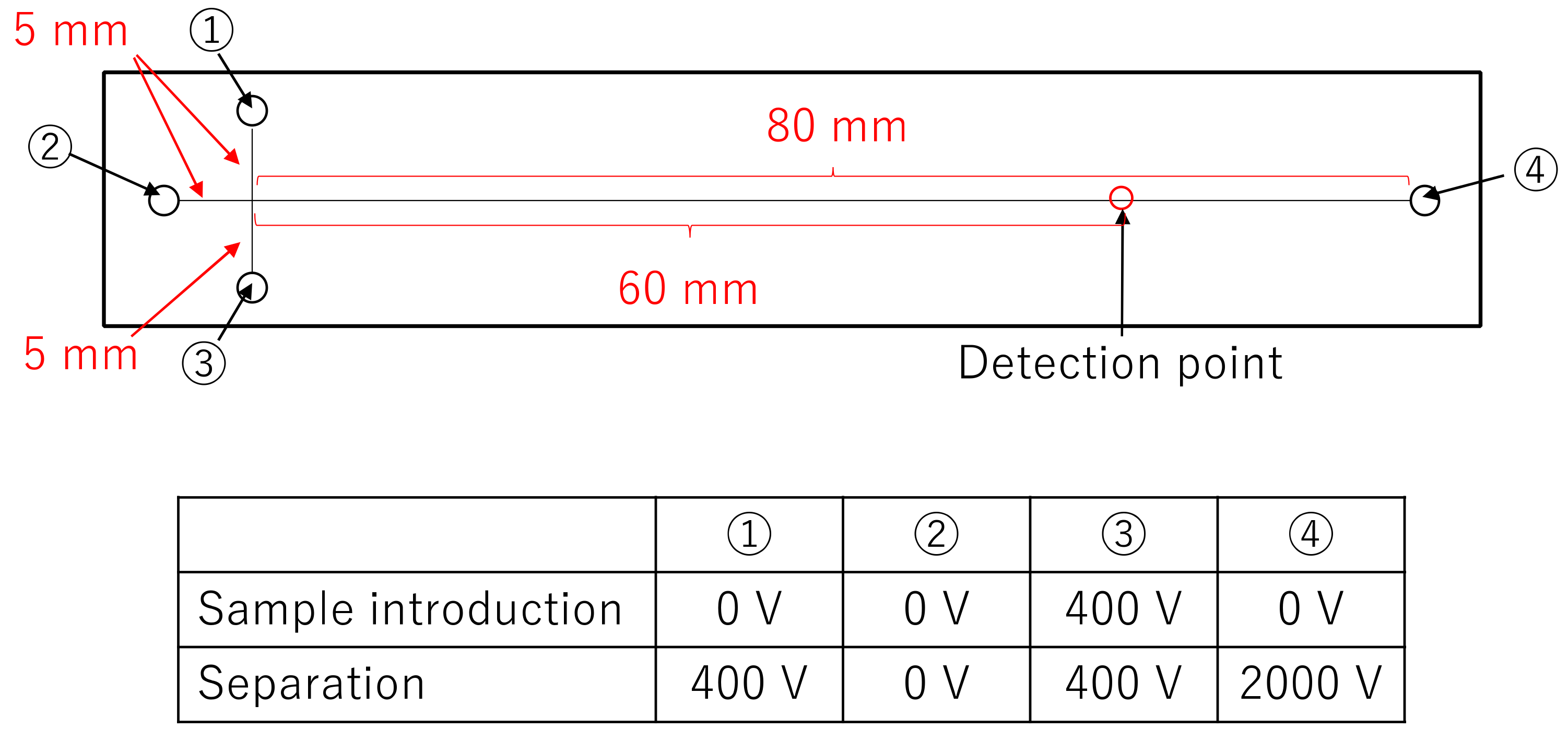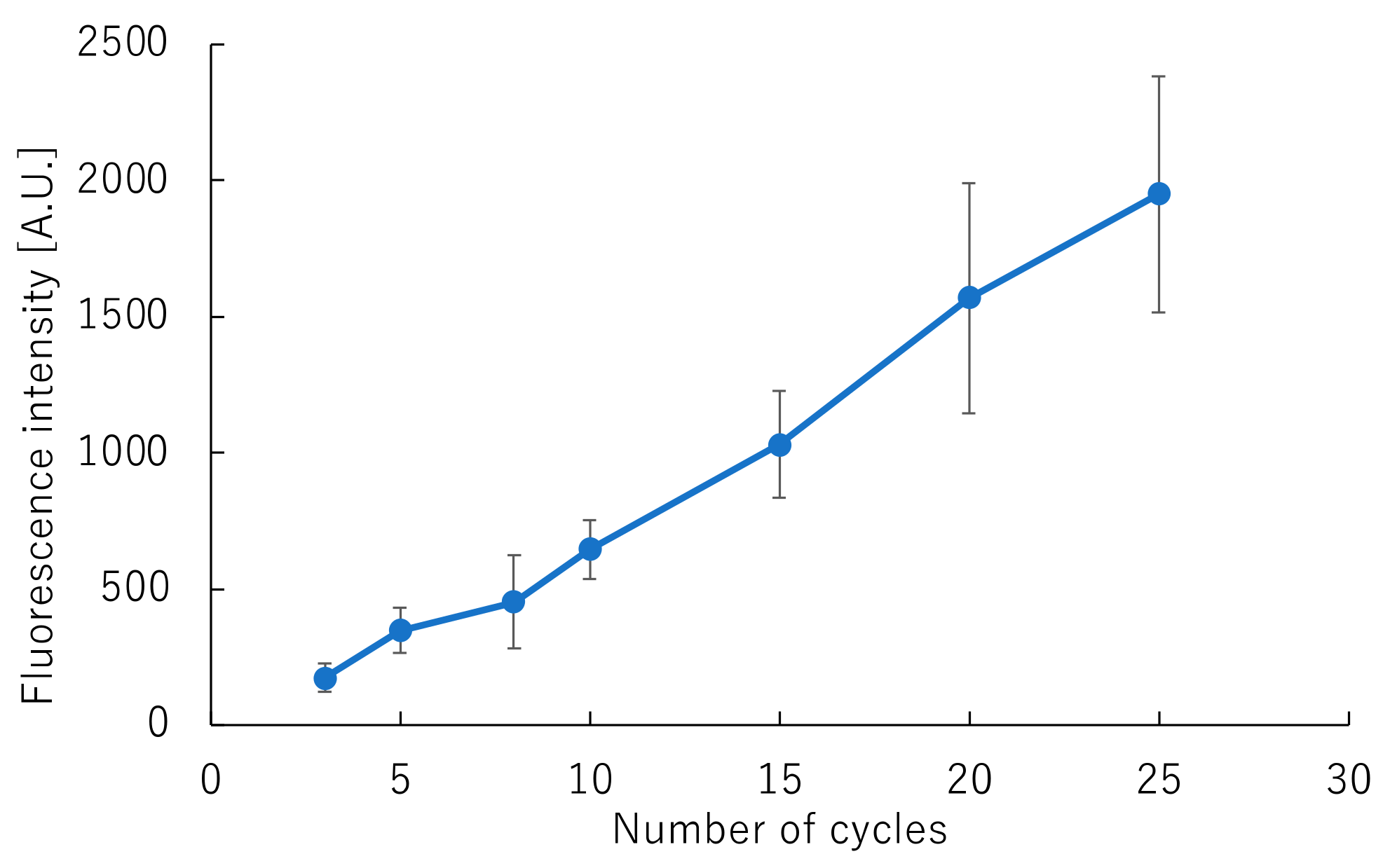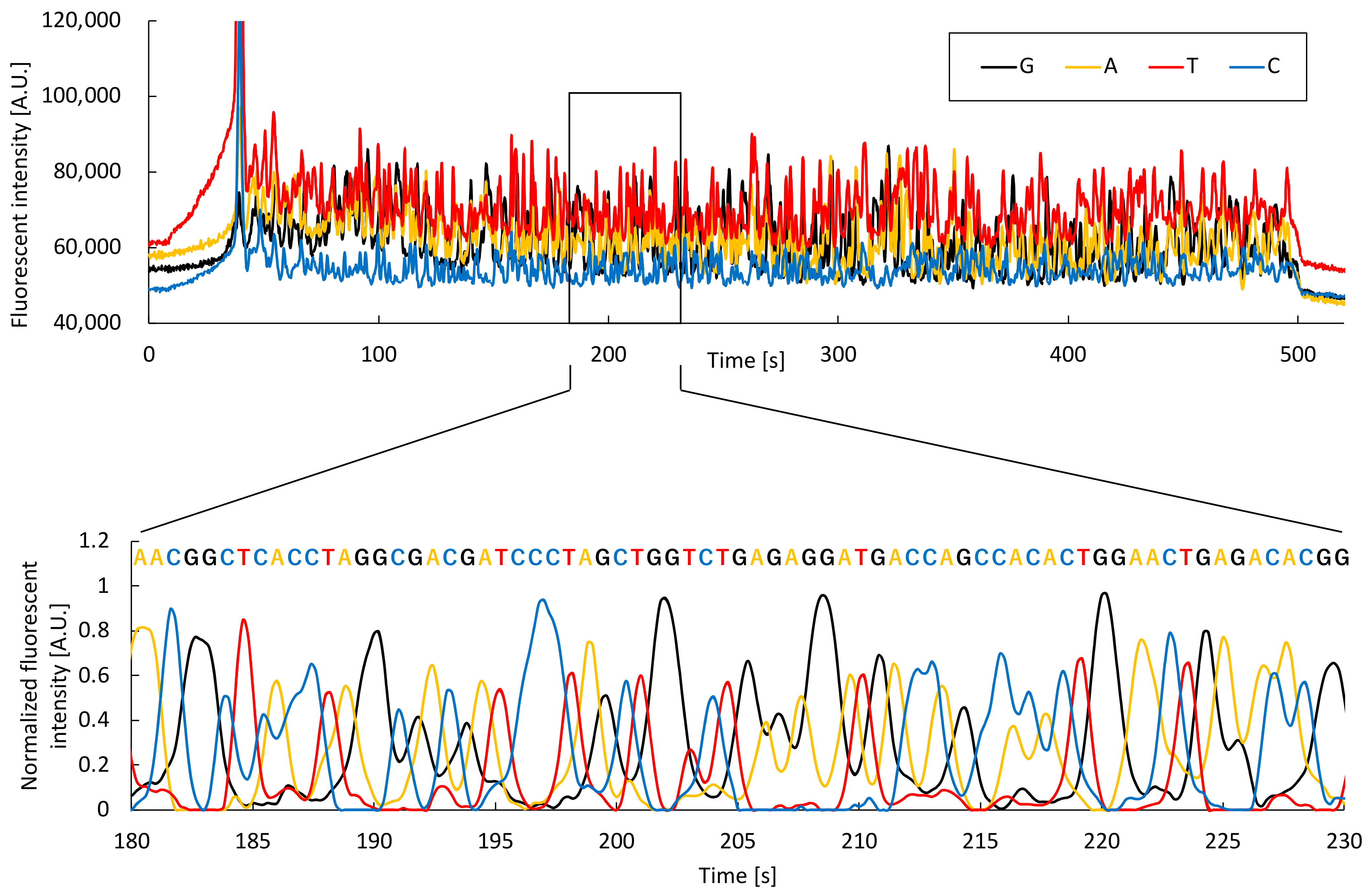Rapid DNA Sequencing Technology Based on the Sanger Method for Bacterial Identification
Abstract
:1. Introduction
2. Materials and Methods
2.1. Rapid PCR
2.2. Rapid Cycle Sequencing for Fluorescent Labeling
2.3. PCR and Cycle Sequencing Using Conventional Instruments
2.4. Microchip Electrophoresis
2.5. Algorithm for Analyzing Microchip Electrophoresis
3. Results & Discussion
3.1. Rapid PCR
3.2. Rapid Cycle Sequencing for Fluorescence Labeling
3.3. Microchip Electrophoresis
4. Conclusions
Supplementary Materials
Author Contributions
Funding
Institutional Review Board Statement
Informed Consent Statement
Data Availability Statement
Conflicts of Interest
Abbreviations
| AMR | Antimicrobial Resistance |
| MALDI-TOF MS | Matrix Assisted Laser Desorption/Ionization Time-Of-Flight Mass Spectrometry |
| rDNA | Ribosomal DNA |
| NGS | Next-Generation Sequencing |
| PCR | Polymerase Chain Reaction |
| μTAS | Micro Total Analysis Systems |
| PMT | Photomultiplier Tube |
| BPF | Band Pass Filter |
| DM | Dichroic Mirror |
| LPF | Long Pass Filter |
| PDMA | Poly(N,N-dimethylacrylamide) |
| LOD | Limit of Detection |
References
- Silver, L.L. Challenges of Antibacterial Discovery. Clin. Microbiol. Rev. 2011, 24, 71–109. [Google Scholar] [CrossRef] [PubMed] [Green Version]
- Singer, A.C.; Kirchhelle, C.; Roberts, A.P. (Inter)nationalising the antibiotic research and development pipeline. Lancet Infect. Dis. 2020, 20, e54–e62. [Google Scholar] [CrossRef]
- de Kraker, M.E.A.; Stewardson, A.J.; Harbarth, S. Will 10 Million People Die a Year due to Antimicrobial Resistance by 2050? PLoS Med. 2016, 13, e1002184. [Google Scholar] [CrossRef] [PubMed] [Green Version]
- National Action Plan on Antimicrobial Resistance (AMR) 2016–2020. Available online: https://www.mhlw.go.jp/file/06-Seisakujouhou-10900000-Kenkoukyoku/0000138942.pdf (accessed on 12 January 2022).
- Gaieski, D.F.; Mikkelsen, M.E.; Band, R.A.; Pines, J.M.; Massone, R.; Furia, F.; Shofer, F.S.; Goyal, M. Impact of time to antibiotics on survival in patients with severe sepsis or septic shock in whom early goal-directed therapy was initiated in the emergency department. Crit. Care Med. 2010, 38, 1045–1053. [Google Scholar] [CrossRef] [PubMed]
- Lagier, J.-C.; Edouard, S.; Pagnier, I.; Mediannikov, O.; Drancourt, M.; Raoult, D. Current and Past Strategies for Bacterial Culture in Clinical Microbiology. Clin. Microbiol. Rev. 2015, 28, 208–236. [Google Scholar] [CrossRef] [PubMed] [Green Version]
- Moon, J.; Kim, N.; Kim, T.-J.; Jun, J.-S.; Lee, H.S.; Shin, H.-R.; Lee, S.-T.; Jung, K.-H.; Park, K.-I.; Jung, K.-Y.; et al. Rapid diagnosis of bacterial meningitis by nanopore 16S amplicon sequencing: A pilot study. Int. J. Med. Microbiol. 2019, 309, 151338. [Google Scholar] [CrossRef] [PubMed]
- Shin, J.; Lee, S.; Go, M.-J.; Lee, S.Y.; Kim, S.C.; Lee, C.-H.; Cho, B.-K. Analysis of the mouse gut microbiome using full-length 16S rRNA amplicon sequencing. Sci. Rep. 2016, 6, 29681. [Google Scholar] [CrossRef] [PubMed] [Green Version]
- Mitsuhashi, S.; Kryukov, K.; Nakagawa, S.; Takeuchi, J.; Shiraishi, Y.; Asano, K.; Imanishi, T. A portable system for rapid bacterial composition analysis using a nanopore-based sequencer and laptop computer. Sci. Rep. 2017, 7, 5657. [Google Scholar] [CrossRef] [PubMed]
- Moon, J.; Jang, Y.; Kim, N.; Park, W.B.; Park, K.-I.; Lee, S.-T.; Jung, K.-H.; Kim, M.; Lee, S.K.; Chu, K. Diagnosis of Haemophilus influenzae Pneumonia by Nanopore 16S Amplicon Sequencing of Sputum. Emerg. Infect. Dis. 2018, 24, 1944–1946. [Google Scholar] [CrossRef] [PubMed]
- Manz, A.; Harrison, D.J.; Verpoorte, E.M.J.; Fettinger, J.C.; Paulus, A.; Lüdi, H.; Widmer, H.M. Planar chips technology for miniaturization and integration of separation techniques into monitoring systems: Capillary electrophoresis on a chip. J. Chromatogr. A 1992, 593, 253–258. [Google Scholar] [CrossRef]
- Emrich, C.A.; Tian, H.; Medintz, I.L.; Mathies, R.A. Microfabricated 384-Lane Capillary Array Electrophoresis Bioanalyzer for Ultrahigh-Throughput Genetic Analysis. Anal. Chem. 2002, 74, 5076–5083. [Google Scholar] [CrossRef] [PubMed]
- Roux, D.L.; Root, B.E.; Reedy, C.R.; Hickey, J.A.; Scott, O.N.; Bienvenue, J.M.; Landers, J.P.; Chassagne, L.; de Mazancourt, P. DNA Analysis Using an Integrated Microchip for Multiplex PCR Amplification and Electrophoresis for Reference Samples. Anal. Chem. 2014, 86, 8192–8199. [Google Scholar] [CrossRef] [PubMed]
- Fredlake, C.P.; Hert, D.G.; Kan, C.-W.; Chiesl, T.N.; Root, B.E.; Forster, R.E.; Barron, A.E. Ultrafast DNA sequencing on a microchip by a hybrid separation mechanism that gives 600 bases in 6.5 minutes. Proc. Natl. Acad. Sci. USA 2008, 105, 476–481. [Google Scholar] [CrossRef] [PubMed] [Green Version]
- Furutani, S.; Naruishi, N.; Hagihara, Y.; Nagai, H. Development of an on-site rapid real-time polymerase chain reaction system and the characterization of suitable DNA polymerases for TaqMan probe technology. Anal. Bioanal. Chem. 2016, 408, 5641–5649. [Google Scholar] [CrossRef] [PubMed]
- Ewing, B.; Hillier, L.; Wendl, M.C.; Green, P. Base-Calling of Automated Sequencer Traces Using Phred. I. Accuracy Assessment. Genome Res. 1998, 8, 175–185. [Google Scholar] [CrossRef] [PubMed] [Green Version]
- Furutani, S.; Naruishi, N.; Saito, M.; Tamiya, E.; Fuchiwaki, Y.; Nagai, H. Rapid and Highly Sensitive Detection by a Real-time Polymerase Chain Reaction Using a Chip Coated with Its Reagents. Anal. Sci. 2014, 30, 569–574. [Google Scholar] [CrossRef] [PubMed] [Green Version]
- Furutani, S.; Hagihara, Y.; Nagai, H. On-site identification of meat species in processed foods by a rapid real-time polymerase chain reaction system. Meat Sci. 2017, 131, 56–59. [Google Scholar] [CrossRef] [PubMed]
- Reier-Nilsen, T.; Farstad, T.; Nakstad, B.; Lauvrak, V.; Steinbakk, M. Comparison of broad range 16S rDNA PCR and conventional blood culture for diagnosis of sepsis in the newborn: A case control study. BMC Pediatr. 2009, 9, 5. [Google Scholar] [CrossRef] [PubMed] [Green Version]
- Sakai, J.; Tarumoto, N.; Orihara, Y.; Kawamura, R.; Kodana, M.; Matsuzaki, N.; Matsumura, R.; Ogane, K.; Kawamura, T.; Takeuchi, S.; et al. Evaluation of high-speed but low-throughput RT-qPCR system for detection of SARS-CoV-2. J. Hosp. Infect. 2020, 105, 615–618. [Google Scholar] [CrossRef] [PubMed]
- Church, D.L. Principles of Capillary-Based Sequencing for Clinical Microbiologists. Clin. Microbiol. Newsl. 2013, 35, 11–18. [Google Scholar] [CrossRef]







| DNA Sequencing Method | Required Process | Analysis Time | Read Length | Reference |
|---|---|---|---|---|
| Traditional Sanger method | PCR | 9 h or less | 700–900 bp | [21] |
| Cycle sequencing | ||||
| Capillary electrophoresis | ||||
| Nanopore method | PCR | 4.2–7.5 h | 10,000 bp | [7] |
| Library preparation | ||||
| Nanopore sequencing | ||||
| Rapid Sanger method | Rapid PCR | 41 min | 550 bp | This study |
| Rapid cycle sequencing | ||||
| Microchip electrophoresis |
Publisher’s Note: MDPI stays neutral with regard to jurisdictional claims in published maps and institutional affiliations. |
© 2022 by the authors. Licensee MDPI, Basel, Switzerland. This article is an open access article distributed under the terms and conditions of the Creative Commons Attribution (CC BY) license (https://creativecommons.org/licenses/by/4.0/).
Share and Cite
Furutani, S.; Furutani, N.; Kawai, Y.; Nakayama, A.; Nagai, H. Rapid DNA Sequencing Technology Based on the Sanger Method for Bacterial Identification. Sensors 2022, 22, 2130. https://doi.org/10.3390/s22062130
Furutani S, Furutani N, Kawai Y, Nakayama A, Nagai H. Rapid DNA Sequencing Technology Based on the Sanger Method for Bacterial Identification. Sensors. 2022; 22(6):2130. https://doi.org/10.3390/s22062130
Chicago/Turabian StyleFurutani, Shunsuke, Nozomi Furutani, Yasuyuki Kawai, Akifumi Nakayama, and Hidenori Nagai. 2022. "Rapid DNA Sequencing Technology Based on the Sanger Method for Bacterial Identification" Sensors 22, no. 6: 2130. https://doi.org/10.3390/s22062130
APA StyleFurutani, S., Furutani, N., Kawai, Y., Nakayama, A., & Nagai, H. (2022). Rapid DNA Sequencing Technology Based on the Sanger Method for Bacterial Identification. Sensors, 22(6), 2130. https://doi.org/10.3390/s22062130






